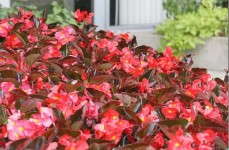Top 5 Performers At Gateway Technical College’s Trial

Trial Manager
Kate Field, horticulture instructor
Location
Kenosha, Wisc.
Planting dates
May 20 to June 10
Entries
Gateway Technical College has been trialing seed and vegetative annuals for three years. Gateway included about 40 seed and 15 vegetative annual varieties this year. It also added about five perennial species and five woody trials this year.
All of Gateway’s trial plants are planted directly in the ground or in above-ground containers. Most of the trials are planted in irrigated beds, but Gateway does have a portion that is hand watered, including the container trials. Perennial trials are planted in both irrigated and non-irrigated beds. Gateway also plant some perennials within 15 inches of sidewalks that receive salt applications for winter ice removal. The perennial trials are ongoing and will evaluate winter hardiness, salt tolerance and garden performance over a three-year period.
The soil in the area is heavy clay with high levels of organic matter. Fir bark mulch is applied during the growing season, but Gateway plans to switch to shredded leaf mulch next year. Gateway evaluates annual seed varieties for greenhouse, as well as landscape performance. In the greenhouse, this includes uniformity of germination, growth and maturity for harvest. Gateway is also interested in annuals that stay compact without the need for plant growth regulators and that hold well in containers at retail. The college grows seeds in a 288 plug tray and shifts up to a 606 flat or 4-inch pot, depending on mature size.
Weather Conditions
Spring 2011 weather in Wisconsin, like much of the country, was exceptionally cold and rainy with crops being as much as two weeks later than “normal” until about late June. Cold and rainy is not exactly unusual for a Wisconsin spring, but the state usually gets a few nice weekends to move spring along and drive garden center sales. Retailers and growers experienced a lot of plant damage and lost sales due to the cold, rainy weather, forcing early clearance sales and markdowns. Several retail garden centers described spring 2011 as one of the worst in 20 years in terms of weather and sales.
Temperatures in Southeast Wisconsin spiked into the 90s and stayed there for several weeks mid to late July, extending off and on into early August. Several days saw heat advisory warnings. The heat was accompanied by lower-than-normal rainfall for the months of August and September.
While not officially considered a drought, conditions were unusually hot and dry. These high temperatures, coupled with low rainfall, meant supplemental irrigation had to be provided to planting beds that normally receive no extra irrigation. Heat stall and heat/drought-related collapse were observed in community flower beds that did not receive irrigation.
Temperatures began to cool rather early and suddenly. By the third week of August, night temperatures in the low 50s were occurring regularly. The month of September has been unusually cool with days in the 60s and many nights in the 40s. The first frost warning was given September 12. The first hard frost usually occurs near October 15 in Southeast Wisconsin with warmer temperatures near Lake Michigan. A light frost and cold injury was experienced on warm season crops as early as September 12 in western Kenosha County and into Southwestern Wisconsin.
Top Varieties
Here are the five favorites at Gateway Technical College:
1. Begonia ‘Whopper’

Begonia ‘Whopper Red with Bronze Foliage’
Gateway received begonia Rose with Green Leaf and Red with Bronze Leaf from Ball Horticultural Co. Both were exceptional plants. The Red with Bronze Leaf was the most striking with excellent contrast between shiny, dark bronze leaves and bright red flowers on a compact, full plant. Begonias from seed often exhibit sporadic germination, but these pelleted seed had uniform germination and growth.
Gateway was able to transplant all 288 plugs into 606 trays all at once. Plants held nicely in the 606, even though the college decided it would be better to market them as a 4-inch or larger to better differentiate them from standard wax begonias and show off their huge flowers.
Landscape performance was excellent. Gateway had Rose with Green Leaf planted in a shade location with the new lime green ‘Wasabi’ coleus, which made very attractive contrasting partners.
Red with Bronze Leaf was planted in a non-irrigated bed in front of a building. Gateway was impressed with the adaptability of this begonia to full sun, reflected heat and inconsistent soil moisture. The area had some very hot weeks this summer, and this plant came through without any heat stall at all. It looked beautiful all summer and now into fall continues to produce non-stop blooms under increasingly cool night temperatures in the low 50s.
Gateway also has some in containers that have filled out the pot beautifully. Gateway plans to use more next year in mixed containers.
2. Portulaca ‘Happy Hour Orange’

Portulaca ‘Happy Hour Orange’
There are seven colors in this series: Deep Red, Fuchsia, Orange, Peppermint, Coconut, Lemon and Banana. Gateway liked the soft warm papaya shade and vigor of the orange color best. It looks beautiful with blue shades of petunias or salvia and also works well contrasting with dark red and yellow shades of lantana.
Gateway also likes the Deep Red and Banana colors planted together in a bed with a backdrop of celosia ‘New Look Scarlet,’ which made a very dramatic show. The banana is a dark yellow color flecked with red in the center.
Plants had uniform germination and held well in the greenhouse during low light days of spring with no sign of powdery mildew. Gateway had to keep plants in greenhouse 606 trays a little longer than it wanted to due to cold weather outside, but they held on beautifully. Happy Hour makes for a colorful and drought resistant ground cover in beds and seem to tolerate poor, salty soil next to sidewalks.
3. Delosperma Carmen Lucia
This is a new perennial from DeVroomen. Gateway obtained the plants as 72 plug trays in spring. Due to the cold weather, Gateway went ahead and shifted them to 288s and grew them for a few weeks before planting in early June.
The series is available in six colors: White Pearl, Eye Candy, Strong Red, Pink Ribbon, Perfect Orange and Carmen Lucia. Carmen Lucia performed the best for Gateway overall this year, but it will also be evaluating plants for winter hardiness next year. Strong Red was the frontrunner for vegetative growth and spread early on.
By midsummer, Carmen Lucia had caught up in size and spread and definitely had the best flower cover of the series. Gateway has this trial in both irrigated and non-irrigated locations. Plants benefitted by supplemental irrigation over the summer but over the past few weeks of fall with cooler temperatures and a little rain, the difference in growth and flowering is minimal.
Gateway is hopeful for their winter survival as they are a very cool plant. They began blooming in the plug tray and continued to bloom all summer. This plant has great potential as a drought tolerant groundcover. It also has a dense growth habit to effectively choke out weeds.
4. Hibiscus ‘Mahogany Splendor’

Hibiscus ‘Mahogany Splendor’ and coleus ‘Wasabi’
This plant features dark reddish purple foliage. It grows to about five feet. The leaves are finely dissected and give the texture and color of a Japanese maple. This plant definitely likes warm weather and after a bit of a slow start in spring, it took off to become a focal point in large beds and containers. In full sun, the plants grow to be compact and form a tight hedge when planted close. In shadier sites they grow more upright to spreading. They are a tough plant that can take a wide variety of conditions from hot sun and drought to some shade and wet soil.
Overall, these grow best in full sun with consistent moisture. Japanese beetles didn’t attack like they do most other hibiscus. They look great with coleus ‘Wasabi,’ another one of Gateway’s trial favorites.
5. Bidens ‘Sunbeam’
This is a very tough little plant with cheerful bright yellow flowers and fine-textured spreading foliage. This plant is useful in many ways, from a fast-spreading and low-growing groundcover to a container “spiller.” Bidens weaves its way in and out of other plants with its yellow, daisy flowers and fine-textured leaves. Heat and drought tolerant, it bloomed all summer in a large concrete container on the south side of a building with massive reflected heat. It looked great all summer!










